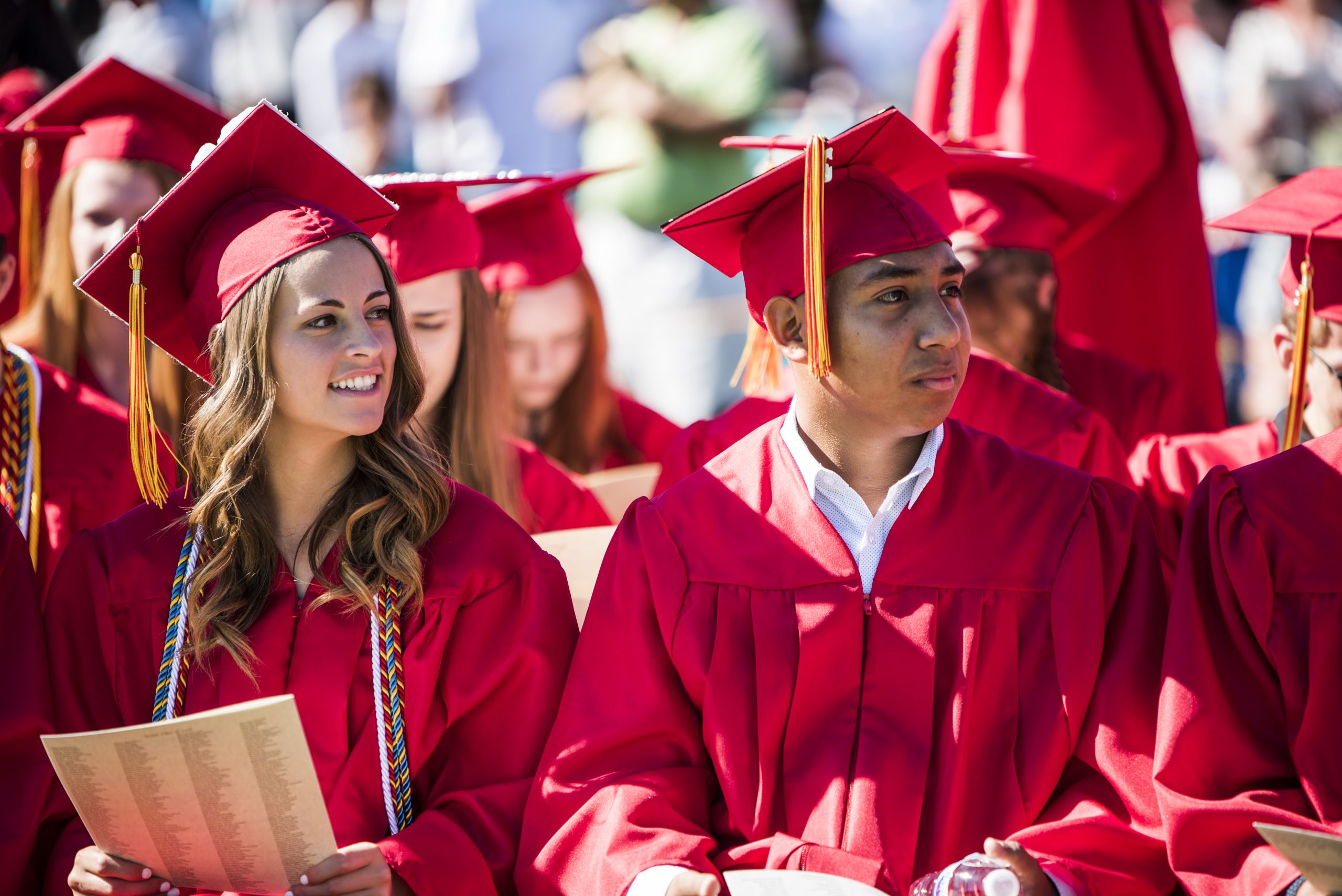Pathways in Technology Early College High School (P-TECH) is a new type of school that brings together the best elements of high school, college and the professional world.
P-TECH is a model that Skyline offers, allowing students to earn a high school diploma as well an Associates of Applied Science degree in Computer Information Systems (CIS) at no cost from Front Range Community College. This program includes significant internship and mentorship opportunities with IBM, giving students a head start in their career after completing the program. Students enroll in 9th grade and complete the program in 4-6 years.
Earn a no-cost Associate’s Degree in Computer Information Systems
P-TECH started at Skyline in 2016 as a cooperative agreement with Front Range Community College (FRCC) and IBM giving St. Vrain students the opportunity to graduate with a high school diploma and Associates of Applied Science (AAS) degree in 4-6 years.
Along with college courses, students will receive mentorships and internships through IBM to provide real-world experiences to supplement their academic coursework.
Students must apply for the P-TECH program and will begin college coursework in the 9th grade. Positions within the P-TECH program are limited, so apply as soon as possible.
- Download a flyer in English or Spanish.
- Students who are interested in applying to P-TECH for the school year 2023-2024, please fill out THIS APPLICATION.
- Teacher Reference Form
Skyline High School P-TECH program recognized for advancing student opportunities on the floor of the U.S. House of Representatives
Capstone Celebrations
Virtual Capstone Celebration 2021
Congratulations to our many seniors who have worked so hard during high school to not only meet graduation requirements, but went above and beyond with a Capstone. From Visual and Performing Artists sharing their talents with the public and also creating an online portfolio, to AP Capstone students finishing a 30+ page research paper on a topic of their choice, to STEM students designing and building something to solve a problem they identified, these students exemplify what it takes to strive for excellence and contribute to our community. We celebrate each and every one of them! What follows is a message from our principal, along with student representatives from each of the four capstone areas. Then enjoy hearing from each of our Capstone students as they share their post-graduation plans. Last but certainly not least, there are links to student capstone work. Enjoy looking through the incredible work these students have completed during their time here at Skyline.
Principal Ringer’s Welcome & Student Speeches (Video)
Hear from Riley Primeau (STEM), Lily Peterson (VPA-Performing), Louisa Wilson (AP Capstone), and Sofia Narvaez (VPA-Visual) as they reflect on their time in their programs.
https://drive.google.com/file/d/14dJ3B085Uz1z73GFHIYEl-wegTyjUXem/view?usp=sharing
Senior Capstone Students (Video)
Find out the post-grad plans of our Capstone seniors by watching the video below.
https://drive.google.com/file/d/1Tk-PJcP824kxQ6JneZn9hwT-OljeY4Hs/view
STUDENT CAPSTONE WORK:
Visual Art
Performing Art
Ulises Mendoza
STEM
Pierce Anderson, Karsen Box, Justyn Byrnes, Emory Chow, Camryn James: Semi-Autonomous Climate-Controlled Greenhouse
Sophie Bush, Lucas Hart, Ashley Kaster, Paola Rubi, and Shuchi Shah: Sugar Spinner
Hailey Crossland, Alejendro Gutierrez, Natalie James, Nathan Mickelson, Chase Silva: Hail Protection for Vehicles
Nolan Helmstetter, Savannah Jimenez, Joe Murtagh, Riley Primeau, Dylan Stype, Justin Wright: Safe Mountain Biking Handlebars
JT Higgins, Nick Pratt, Royce Quinones, John Reed, Savannah Young: S Mirror
AP Capstone:
Hailey Crossland: Technological Communications and Mental Health of Teens
We use devices constantly in everyday life; to talk to others and be connected, to learn, and more. For my study, I wanted to understand whether there is a correlation between the mental health of teenagers and their usage of technology, more specifically how they are communicating and with whom. My research question to get a better understanding of this is: “How is the way teenagers use technology to communicate affecting their well-being?” The survey was distributed to 14 to 18 year olds, asking the participant a variety of questions by mass spreading the link to the survey. The results that are concluded from the survey would allow me to better understand one fraction of the on-going conversation about technological effects. This is important because the study was done on one of the main uses of phones which is an extremely common device that people within my age group uses, giving me the most accurate data for my study. And as this only does take a look at one aspect of device usage, it still is key to understanding the bigger picture for a seemingly controversial topic in the media.
Sara Davis: The Fight, Flight, or Freeze Response in Childhood
This study, using a method of fixed-effect meta-analysis examines the presence of a fight, flight, or freeze response in children. In adults, managing the fight or flight response is taught as a skill and a component of conflict resolution. However, in young children, research is restricted to examining this effect in children experiencing trauma. The established prevalence of the fight, flight, or freeze response in adult life begs the question of what this response looks like in childhood. Examining behavior through this lens allows adults to better understand and evaluate a child’s response, making it easier for children to grow into the social-emotional skills they will need in adulthood.
Sophia Kruse: The Relationship Between Self Esteem and Social Role
In recent times, the occurrence of low self-esteem in the United States has grown to effect approximately 85% of all American adolescents. Previous research has shown a link between the self-esteem levels of adolescents who are leaders of a group versus followers (leaders having higher self-esteem and followers having lower self-esteem). This finding from the pre-existing research sparked the goal of this study: to determine if there is a correlation between an adolescent’s self-esteem level and their social role within a group.
To determine each participant’s social role and self-esteem level a quantitative questionnaire was used, including adaptations of questions from the pre-validated Rosenberg Self-Esteem scale to access each individual’s self-esteem level. To establish if there was a correlation between social role and self-esteem level, quantitative analysis was done on the survey results.
It was concluded that for seven of the eight social roles, there was a strong relationship to one general self-esteem level, providing convincing evidence of an existing correlation.
Beck Lawrence: Star Wars, Disney, and Fan Culture
The sci-fi epic film series Star Wars is an incredibly influential and popular franchise with an incredibly devoted fan base. The release of the new Disney Star Wars trilogy sparked controversy among fans concerning the depiction of protagonist Luke Skywalker. This study seeks to examine how closely the portrayal of Skywalker in the Disney trilogy adheres to his portrayal in the original trilogy with the purpose of highlighting differences between the creators’ ideas of Skywalker and the fans’ ideas. It does this by analyzing the prevalence of Skywalker’s core characteristics over the course of the saga. It was discovered that Skywalker’s character remained the same throughout both trilogies, but the development his character experienced in the original trilogy was negated in the Disney trilogy. This discovery can lend further insight into interactions between fans and creators.
Shuchi Shah: Comfortability of Ethnic Diversities in the STEM Workplaces
Ethnic diversity in the STEM workplace is an ever-changing subject. Diversity makes the workplace heterogeneous. In today’s world, having a diverse workforce is a necessity for almost every organization out there, but what does this mean for employers is still a question that stands. After examining the literature and various research papers, a survey using the Likert Scale has been conducted to try to answer this question. This survey was given out through emails to companies that are part of the STEM field. Through the collection of data, six major topics were looked into. These topics were attitudes toward diversity, inclusion, and corporate culture; discrimination and harassment; hiring and recruitment; your immediate supervisor; diversity training program; and evaluation and promotion. A conclusion will be made on how different diversity feels towards their jobs regarding diversity through the analysis of these topics.
Ashwini Shrestha: Determining the Awareness Levels of and Actions Taken Against Fast Fashion in Young Adults Compared to Older Age Groups in Colorado
Fast fashion and consumerism are detrimental to the natural world and are a causing factor of global warming. Previous studies have found differences between age groups and their perception and awareness of environmental issues, such as resource scarcity, environmental
policies, conservation behaviors, and more. This discovery from the pre-existing research helped catapult the goal of this research study: to determine the awareness levels of and actions taken against fast fashion and its implications on the environment in young adults (14-20) compared to older age groups. To examine these behaviors among 391 Colorado residents, a survey methodology was used. It was concluded that the youngest age group (14-20) has taken the most action against fast fashion, has the same amount of awareness as the older age groups, and are less cognizant of their daily consumption behaviors than the older age groups. In addition, the age group consisting of 36-50 year olds was the least aware of and has taken the least action against fast fashion. The last conclusion made was that the 51-80 year old age group were the most aware of and responsible for where their clothing comes from and where it will go.
Louisa Wilson: Analyzing the Relationship Between the Public and Criminal Justice System Biases Towards Drugs
Laws surrounding drug criminalization and drug use in the United States have been scrutinized and revised often in recent years, significantly with the “War on Drugs” beginning in the 1970s. With previous research, the relationship between the biases and opinions of the public and the biases and actions of the American criminal justice system towards drug legislation is unclear. The goal of this research study is to answer the guiding research question: “How is societal bias about drugs correlated with systemic bias on drug punishment and legislation?”.
To assess the relationship between public bias and the bias of the American criminal justice system towards drugs, a survey methodology was used, 393 respondents from Colorado, centered in Boulder County. The survey included 51 questions in order to gauge the implicit and explicit biases of Colorado residents towards drugs and drug legislation.
It was concluded that the biases of both the public and the criminal justice system align on some topics and differ on others. The views of Colorado residents and the federal justice system are similar in the general discussion of drugs and risk of harm associated with drug use. However, the views of Colorado residents and the justice system differ on the topic of punishment and criminalization.
Tallia Wilson: The Halo Effect: How Appearance Affects the Way People are Treated and Perceived on Social Media
Many researchers have explored the psychological phenomenon referred to as the halo effect; the tendency for an impression in one area to influence the opinion in another area. Previous researchers have explored this idea through a variety of different lenses, including political and scientific, proving the legitimacy of the effect. However, what has yet to be studied is how the halo effect affects social media users. Specifically, how physical appearance affects the way people are treated and perceived on social media.
To explore the relationship between appearance and the way people are treated and perceived on social media, a survey was conducted. To establish if there was a correlation, a qualitative analysis was done on the results. It was concluded that appearance does have a strong influence on how individuals are perceived on social media, however the data did not provide strong enough evidence to conclude that people were treated any differently.
Virtual Capstone Night Video

Capstone Work:
AP Research
Katelynn Archer: “Content Analysis of Female Serial Killers in the Media”
Ethan Coulter: “Instrumental Music and Effectiveness for Evoking Emotion”
Roman Garcia-Martinez: “The Truth of Latinx Culture in Colorado High Schools”
Molly Hennessy: “The Effectiveness of Teaching Communication Skills to Kids Diagnosed with Autism Spectrum Disorder Through the Means of Therapeutic Riding”
Connor Kelso: “Art in the Context of Streaming: Digitalization’s Toll on Song Length”
Aron Messinger: “Comparison Between Prosthetic Hand Drive Systems”
Logan Oliver: “Analyzing the Effects of Online Political Activity on Young Voters During the 2016 Election”
Brooke Parkinson: “A Content Analysis Study of the Bystander Effect in Media”
Reba Shrestha: “Analysis of Physical Therapy”
Abigail Stoops: “Animal-Assisted Activities in Aiding Human Recovery”
VPA – Visual
Maria Felan Wolfe: Portfolio
Nikky Sims: Portfolio
McKayla Perley: Portfolio
Justin Jurado Regalado: Portfolio
VPA – Performing
Ethan Coulter: Portfolio Solo 1 Solo 2
Hannah Lewis-Bonneville: Portfolio Solo
Ella Movick: Portfolio Solo
Samantha Oravec: Portfolio Solo
Heather von Niederhausern: Portfolio Solo
STEM
Baton Timer: Matthew Copley, Mason Jones, Jansen Herrmann, Sophia Lindauer, Amelia Rojas, Creighton Trembly
EcoBike: Amber Copley, Jennifer Dunder, Logan Oliver, Tyler Oravec, Dalton Smith
Wheelchairables: Christopher Roy, Braeden Elwood, Tyler Falkinburg, Jeremiah Jones, Riley Young
War Table: Skylar Henry, Alan Misch, Benjamin Morrison, Nathaniel Salazar
Interactive Disposable Bin: Vanshita Gosain, Uriel Martinez




